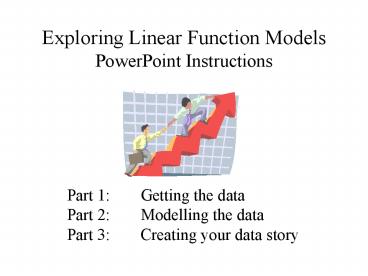Exploring Linear Function Models PowerPoint Instructions - PowerPoint PPT Presentation
1 / 48
Title:
Exploring Linear Function Models PowerPoint Instructions
Description:
Exploring Linear Function Models. PowerPoint Instructions. Part 1: Getting the data ... Click on the United Kingdom link. Click on the Results and Data button. ... – PowerPoint PPT presentation
Number of Views:34
Avg rating:3.0/5.0
Title: Exploring Linear Function Models PowerPoint Instructions
1
Exploring Linear Function ModelsPowerPoint
Instructions
Part 1 Getting the data Part 2 Modelling the
data Part 3 Creating your data story
2
Part 1 Getting the data
3
Open your web browser and type www.censusatschool.
ca
Click on Related sites
4
Click on the United Kingdom link.
5
Click on the Results and Data button.
6
Click on the Random Data Selector button.
7
Click on the Next Page link.
8
Click on the Combined link.
9
Click on the pull-down arrow and select Age 14.
Type in 100 records.
Type in your schools name.
Type in your name.
Type in your e-mail address.
Click on Submit Request.
10
Here is a summary of the data that will be sent
to you via e-mail.
11
Part 2 Modelling the data
12
Use a spreadsheet program (such as QuattroPro or
Excel) to open the file.
13
Click on Edit, then Select All.
14
Click on Edit, then click on Copy.
15
Open your statistics software program (such as
Fathom) and select New Collection.
16
Left-click in your blank document and you will
see Collection 1.
17
Click on Edit, then click on Paste Cases.
18
Collection 1 now has data. Double-click on
Collection 1.
19
Here, you can see that we have 19 attributes and
100 cases.
20
Open up an Empty Plot.
21
Grab onto the heightcm attribute.
22
Drag the heightcm attribute over to the
horizontal axis of your empty plot and let go.
23
You now have a dot plot where each dot represents
a person.
24
Grab and drag the FootSizecm attribute over to
the vertical axis of your plot and let go.
25
You now have a scatter plot, where each dot
represents a person.
26
Click on Graph and select Movable Line.
27
The brown line is the movable line that you can
fit to your data.
Note the equation of your movable line.
28
Grab and rotate the bottom of your movable line.
29
Grab and slide the middle of your movable line.
30
Grab and rotate the top of your movable line.
31
Click on Graph and select Least-Squares Line.
32
The red line is your least-squares line.
Note the equation of your least-squares line.
33
Double-click on any data point that looks
interesting to you. The Inspect Collection window
will show you all the information for that person.
34
Click on Data and select Add Filter.
35
The Edit Filter dialogue box appears. Filter out
boys by typing in Gender F. Click on OK.
36
You now see only girl cases. Note the filter,
Gender F, at the bottom of the scatter plot
window.
37
To filter out the girls, first double-click on
Gender F.
38
Then type Gender M in the Edit Filter
dialogue box.
39
You now see only boy cases. Note the filter,
Gender M, at the bottom of the scatter plot
window.
40
Now, filter out all students except those from
the United Kingdom by typing Country UK in
the Edit Filter window.
41
You now see only United Kingdom cases. Note the
filter, Country UK, at the bottom of the
scatter plot window.
42
Now, filter out all but the South Africa cases.
43
Now, filter out all but the Queensland
(Australia) cases.
44
Part 3 Creating your data story
45
To copy a data display, select it by clicking on
or inside it.
46
Click on Edit and select Copy Picture.
47
Now, open your presentation software. Click on
Edit and select Paste.
48
Your data display image should now be in your
presentation software page, where you can resize
and reposition it.































